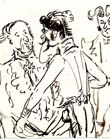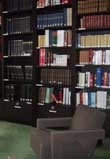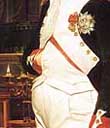| |
| |
EDITORIAL
Ten years of closure and 38 million euros of restoration work later, the Paris Museum of Decorative Arts, set in the Marsan Wing and Pavilion at the Louvre, is to re-open its doors today, 15 September. The principal institution was founded in 1864 and named Union centrale des Arts décoratifs in 1882. The simpler title Arts décoratifs was adopted in 2004. Today it houses also the Musée des Arts décoratifs (installed at rue de Rivoli in 1905), the Musée de la Mode et des Textiles, the Musée de la Publicité, the Bibliothèque des Arts Décoratifs, the Musée Nissim de Camondo and the Ecole Camondo.
Now containing more than 150,000 objects, the Musée des "Arts déco" is an extraordinary testimony to the talent of artists, cabinet makers, jewellers, etc from Mediaeval times to the present day. The two Empires are particularly well represented. So next time you're in Paris, don't forget to visit this temple of Napoleonic treasures...
Irène Delage, tr. P.H.
Editor

|
|
|
| |
THIS MONTH'S PAINTING
Napoleon in his study at the Tuileries, by Jacques-Louis David
Everything in this painting is designed to tell the story of Napoleon's civic genius. As David put it, "Napoleon is in his study, having just spent the night writing the Code Napoléon. The only sign that dawn is breaking is that the candles are burnt down and going out, and by the fact that the clock has just struck four in the morning. So he gets up from his desk in order to put on his sword and to go to review his troops". Read on...

|
|
|
| |
 |
 |
EXHIBITION: NAPOLEON III AND EUROPE - 1856
After organising the conference held on 24 and 25 March this year on the Congrès de Paris (1856), the French Ministry of Foreign Affairs is to present, in collaboration with the Paris Musée de l'armée, a temporary exhibition on Napoleon III and Europe. Including about one hundred original items (engravings, caricatures and Epinal images, official portraits and the important treaties, notably the renowned Traité de Paris), the exhibition aims to show how the Congrès de Paris marked a turning point for Europe. Napoleon III, emerging victorious from the Crimean War (1853-1856), found himself able to pose as the arbiter of a new Europe founded on the principle of nationalities. The scenography of the exhibition, to be held at Les Invalides from 28 September to 28 December, 2006, has been designed by Michel Albertini, designer of the exhibition, The Treasures of the Fondation Napoléon.
Diplomatic soirée, Auguste Louvrier de Lajolais © Paris, Archives du Ministère des Affaires étrangères
For further information:
- On the exhibition
- On the conference dedicated to the «Congrès de Paris (1856), a founding moment»

|
|
|
| |
 |
 |
THE MERCURE DE FRANCE NOW AVAILABLE AT THE FONDATION'S LIBRARY
The Bibliothèque Martial Lapeyre-Fondation Napoléon has acquired a collection of the periodical, Mercure de France.
The Mercure is one of the oldest and best-known literary reviews in France. It owed its name to Mercury, the messenger of the gods, whose symbol (the winged helmet) was printed on the title page. Founded at the end of the 17th century with the title Mercure galant, the literary review became the Mercure de France in 1724. Although it had closed 1780, the review was resuscitated in 1800 by Lucien Bonaparte, who at that time was Interior Minister. He appointed Fontanes as the first editor, but the latter was soon replaced by Chateaubriand. Each volume contained poems, long articles of literary criticism, theatre reviews, diverse items of "news", as well as jokes and riddles. In other words, its pages reveal the intellectual life of the First Empire.
In 1807, Chateaubriand, under the cover of a travel book review, compared Napoleon to Nero. Punishment for this was the forced merger of the Mercure with the Décade philosophique, another literary gazette which was critical of the regime, the aim of the fusion being the weakening of both reviews. The new Mercure de France appeared in October 1807 and it was to run (with only one interruption, between April and September 1815) into the 20th century (although the title was variously modified). The series held at the Bibliothèque Martial-Lapeyre stops in 1816.
Chantal Lheureux-Prévot, librarian
© Fondation Napoléon

|
|
|
| |
200 YEARS AGO
16 September, 1806, saw the opening of the Grand salon of painting and sculpture at the Louvre, in Paris: «the crowd of passers-by and art lovers came into the exhibition rooms pell-mell at ten o'clock.» «Amongst the busts of the Emperor, there was one which especially drew the salon public's attention this year, namely that by Monsieur Houdon, since it was held not only to be the one which was closest to nature, but also beautifully executed in accordance with the rules of sculpture. Art lovers thought the resemblance particularly striking.» (Journal de Paris, 25 September, 1806)
Paris, 21 September, 1806: «The Emperor has sent a communication of the highest importance to the assembly of Jews. The aim is to settle once and for all the question of the Jews, by summoning a Great Sanhedrin, composed of seventy members plus its leader. […] The present assembly is invited to announce with all speed in all the synagogues in Europe the date for the convocation of the Great Sanhedrin so that the latter can send envoys to Paris.»
(Journal de l'Empire, 22 September, 1806)
For more on this assembly, see Bulletin 373
150 YEARS AGO
On 21 September, 1856, the Prince Napoléon, cousin of Napoleon III, returned from his long voyage in northern climes. On 21 June, 1856, he had boarded the corvette, La Reine Hortense, heading for Scotland, Iceland, Greenland and Sweden, accompanied by Commandant de La Roncière. The prince had a most original way of communicating his nautical position. Throughout his voyage he threw into the sea, one at a time, fifty or so wooden cylinders attached to floaters. Each cylinder contained a phial containing the ship's positions. Once found, the phials were to be given to the nearest French consul.
(Moniteur universel, 22 September, 1856)
Wishing you an excellent, Napoleonic, week.
Peter Hicks
Historian and Web editor
THE NAPOLEON.ORG BULLETIN, No 382, 15-21 September, 2006
Interested in the work of the Fondation Napoléon? Why not participate, either generally or in a specific project, by making a donation.
© this Napoleon.org weekly bulletin is published by the Fondation Napoléon. Reproduction or all or part of this bulletin is forbidden, without prior agreement of the Fondation Napoléon.

|
|
|
|
|
|
|
|
|
|
WHAT DO YOU THINK?
Stéphane Chauvin is not only an amateur historian of Napoleon but also the artist of a serious, cartoon version of the life of Napoleon. He is looking for feedback. If you would like to participate, please fill in the questionaire on his site.
THIS WEEK in the MAGAZINE
PRESS REVIEW
- French History, Volume 20, Number 2
- The Nelson Dispatch, vol. 9, parts 2 and 3
JUST PUBLISHED
- SCHULTZ Doug, DVD: Napoleon's Final Battle
- SUMMERVILLE C. J., (ed.), Regency Collections: Captain Gronow's guide to life in London and Paris
WHAT'S ON
Conferences
- Napoleonic Association Conference October 2006, Greenwich, London, UK
- Luigi Emanuele Corvetto (1756-1821), financier, lawyer and politician
Genoa–Imperia, Italy
Study Days
- Patrick O'Brian Weekend 2006, Portsmouth, UK
- Napoleon in North-East Italy, Isonzo Valley, Italy/Slovenia
Commemorations
- Historical Bivouac 1806, Jena, Germany
Exhibitions
- Public portraits, private portraits 1770-1830, Grand Palais, Paris, France
- Louis Bonaparte and the Leiden powder explosion, Rotterdam, Netherlands
- Adel im Wandel (Changing nobility) Exhibition in the Prinzenbau and Landeshaus Sigmaringen, Germany
- Das Königreich Württemberg 1806–1918. Monarchie und Moderne (The kingdom of Württemberg 1806–1918. Monarchy and modernity) In the old castle, Stuttgart, Germany
- The price of the new crown: Baden and Wurttemberg as Napoleon's vassal – the Confederation of the Rhine 1806 Wehrgeschichtliches Museum Rastatt, Germany
- Louis Napoleon: at the court of the first King of Holland, 1806-1810, Apeldoorn, Netherlands
Got a problem with the letter? Try the home page: http://www.napoleon.org<<
|
|



